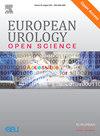Molecular Subtyping for Predicting Pathological Upstaging and Survival Outcomes in Clinically Organ-confined Bladder Cancer Patients Undergoing Radical Cystectomy
IF 3.2
3区 医学
Q1 UROLOGY & NEPHROLOGY
引用次数: 0
Abstract
Background and objective
Many patients with bladder cancer are understaged. Previous work revealed that molecular subtyping using Decipher Bladder improves clinical staging. This multicenter validation study evaluated Decipher Bladder for upstaging in patients who underwent radical cystectomy (RC) without neoadjuvant therapy.
Methods
The Decipher Bladder genomic subtyping classifier (GSC; Veracyte, San Diego, CA, USA) was performed on bladder tumor specimens from patients with high-grade, clinically organ-confined (cTa-T2N0M0) urothelial carcinoma who subsequently underwent RC without neoadjuvant chemotherapy. The primary endpoint was pathological upstaging to non–organ-confined (NOC) disease (pT3+ and/or N+) at RC. The secondary endpoints included overall survival (OS) and pathological upstaging to MIBC+ disease (pT2+ and/or N+) at RC within clinically non–muscle-invasive bladder cancer (cNMIBC) cases.
Key findings and limitations
A total of 226 patients (134 cNMIBC [cTa/Tis/T1] and 92 cT2) were analyzed from eight participating institutions. Upstaging to NOC disease was observed in 33% of patients (19% for cNMIBC and 53% for cT2). Molecular subtyping identified 138 luminal and 88 nonluminal tumors. Rates of upstaging to NOC were 41% in nonluminal and 28% in luminal tumors (univariable p = 0.04), which was not independently significant after adjusting for clinical variables. Upstaging to MIBC+ in cNMIBC patients was lower in luminal versus nonluminal tumors (32% vs 51%, multivariable p = 0.03). Patients with nonluminal tumors had worse OS on multivariable analyses (p < 0.05). Limitations include retrospective design and sample size.
Conclusions and clinical implications
Luminal tumors represent less aggressive disease, reflected by lower rates of pathological upstaging and favorable OS with RC compared with nonluminal tumors.
Patient summary
Molecular subtyping suggests that in clinically non–muscle-invasive bladder cancer, luminal tumors harbor less aggressive disease, as reflected by lower rates of pathological upstaging to muscle-invasive disease and favorable outcomes with radical cystectomy, in comparison with nonluminal bladder cancer.
分子分型预测接受根治性膀胱切除术的器官限制性膀胱癌患者病理分期和生存结果
背景与目的许多膀胱癌患者都处于潜伏期。先前的工作表明,使用Decipher膀胱进行分子分型可以改善临床分期。这项多中心验证研究评估了破译膀胱在接受根治性膀胱切除术(RC)而没有新辅助治疗的患者中的优势。方法膀胱基因组分型分类器(GSC);Veracyte, San Diego, CA, USA)对高级别临床器官受限(cTa-T2N0M0)尿路上皮癌患者的膀胱肿瘤标本进行了检查,这些患者随后接受了RC,没有新辅助化疗。主要终点是RC的非器官局限性(NOC)疾病(pT3+和/或N+)的病理分期。次要终点包括临床非肌肉浸润性膀胱癌(cNMIBC)患者的总生存期(OS)和病理上分期为MIBC+疾病(pT2+和/或N+)。主要发现和局限性我们分析了来自8个参与机构的226例患者(134例cNMIBC [cTa/Tis/T1]和92例cT2)。33%的患者(cNMIBC患者为19%,cT2患者为53%)出现了NOC疾病。分子分型鉴定出138例管腔肿瘤和88例非管腔肿瘤。在非腔内肿瘤中上分期至NOC的比例为41%,在腔内肿瘤中上分期至NOC的比例为28%(单变量p = 0.04),在调整临床变量后无独立显著性差异。与非腔内肿瘤相比,cNMIBC患者在腔内肿瘤中向MIBC+分期较低(32% vs 51%,多变量p = 0.03)。多变量分析显示,非腔内肿瘤患者的OS较差(p <;0.05)。局限性包括回顾性设计和样本量。结论和临床意义:与非腔内肿瘤相比,腔内肿瘤的侵袭性较低,反映在病理上分期较低和RC有利的OS。分子分型提示,与非腔内膀胱癌相比,临床上非肌肉侵袭性膀胱癌的腔内肿瘤侵袭性较低,反映在病理上较低的肌肉侵袭性疾病分期率和根治性膀胱切除术的良好预后。
本文章由计算机程序翻译,如有差异,请以英文原文为准。
求助全文
约1分钟内获得全文
求助全文
来源期刊

European Urology Open Science
UROLOGY & NEPHROLOGY-
CiteScore
3.40
自引率
4.00%
发文量
1183
审稿时长
49 days
 求助内容:
求助内容: 应助结果提醒方式:
应助结果提醒方式:


